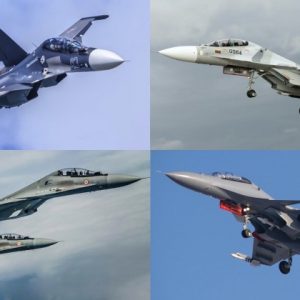
How Capable is Russia’s Prized Su-30 Heavyweight Fighter? Ranking the Seven Operational Variants
Keep up to Date & Bypass the Big Tech Censorship
Get uncensored news and updates, subscribe to our daily FREE newsletter!
Following the development of the Su-27 Flanker, which entered service in 1985 and was widely considered the most capable Cold War era fighter in any world air force, the Soviet Union began development of a number of advanced derivatives including a more capable air superiority aircraft – the Su-27M which later became the Su-35 – and a longer range interceptor. The Su-30 began development as the Su-27PU from 1986, and saw its first flight in December 1989 two years before the Soviet collapse, after which economic crisis and a contracting defence budget significantly slowed progress with just five Su-27PUs delivered by 1996. The the class entered service that year. The program nevertheless continued largely due to export orders, with India becoming the first client and ordering the very basic Su-30K model in 1996 – followed by China which acquired the heavily customised and much improved Su-30MKK. The program would rely heavily on exports to subsidise further research and development costs until the Russian Air Force began to take an interest in the class from the early 2010s. The Su-30 is today fielded in larger numbers worldwide than any other Su-27 derivative, and remains in production today both for the Russian military and for export with capabilities having improved markedly since the 1990s. Approximately 135 are currently deployed by the Russian Air Force, the large majority of them Su-30SMs, with India, China and Algeria being the largest foreign operators. The fighter is prized for pairing the advanced air superiority capabilities of the Su-27 with lower maintenance requirements, and a higher endurance and avionics well suited to strike and anti shipping missions, which make it much more versatile than the original.
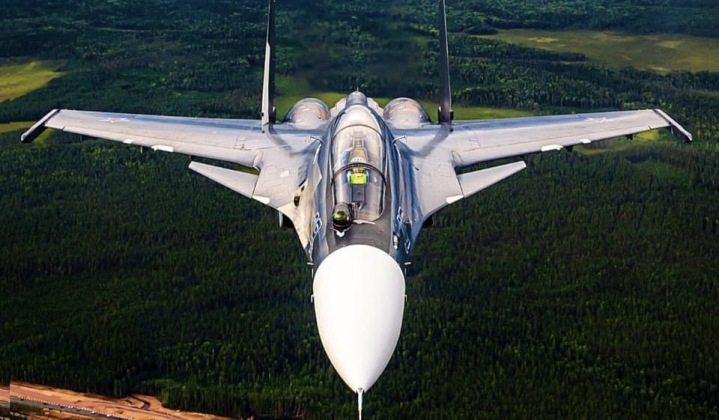
Russian Air Force Su-30SM
Su-30SM2 — Russia
| Recommended Books [ see all ] | ||||
|---|---|---|---|---|
 | 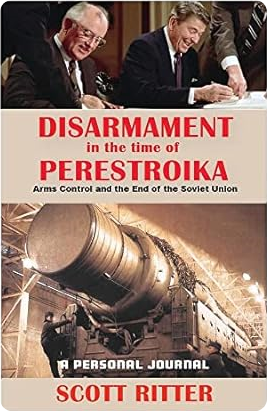 |  |  |
 |
The latest variant of the Su-30, and likely the last production variant intended for domestic use, the Su-30SM2 is expected to enter in the Russian Air Force in considerable numbers represents a major improvement to the Su-30SM design using technologies more recently developed for the Su-35 and Su-57 fighters. The most notable improvements to are the integration of the Su-35’s Irbis-E radar and AL-41 engines. The integration of the Irbis-E radar allows the fighter to detect targets with a three square metre radar cross section 350-400 km away, and against stealth targets with a 0.01 square metre cross section the range is 90 km. The AL-41 meanwhile not only reduce maintenance requirements but also have over 16% more power than the older AL-31 and are more fuel efficient which improves endurance. An integrated multi-channel communication, data exchange, navigation, and identification (OSNOD) system using next generation technologies developed for the Su-57 fighter will also provide a much improved network centric warfare capability. These upgrades will bring the aircraft to a ‘4++ generation’ standard comparable to the Su-35, with the two aircraft expected to be brought into a single production line after 2027 under Russia’s next State Armaments Plan. Much of the Russian Su-30SMs fleet is expected to be enhanced to the Su-30SM2 standard, while further units are produced in parallel.
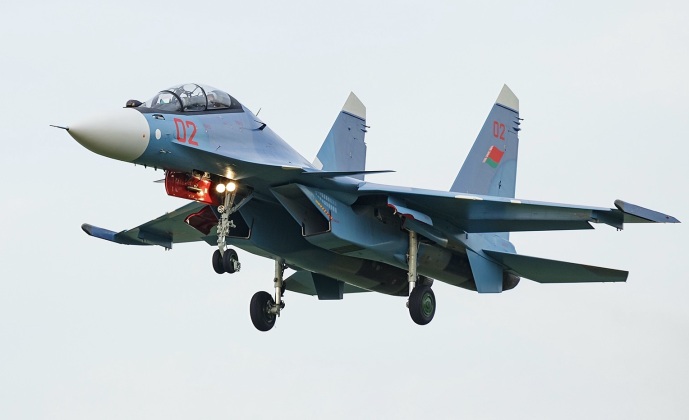
Belarusian Air Force Su-30SM
Su-30SM — Russia, Kazakhstan, Belarus, Myanmar
The Su-30SM is one of the most widely fielded aircraft in Russian service, with an estimated 95 currently used by the country’s air force and a further 22 in the navy. The highly versatile heavyweight jet has been relied on two replace Cold War era MiG-29s, Su-24Ms and Su-27s, and is overall considerably more capable than all of these in all roles while also being much more versatile. Following Russia’s development of the Su-30MKI heavyweight fighter to meet the requirements of the Indian Air Force, which represented the most capable Russian-built fighter at the time, the Su-30SM was developed based on it and provided the country with its first fighter with ‘4+ generation’ capabilities. Alongside thrust vectoring engines for enhanced manoeuvrability, notable features which separated the Su-30SM from older Su-30 variants included the integration of the N-11M Bars radar with a 400km maximum detection range and 200km search range, a wide angle heads up display, new identification friend or foe and communications systems, and compatibility with the SAP-518 jamming pod. The fighter has a lower operational cost than the Su-27, and is considerably cheaper than the Su-35 and Su-57 which, when the Su-30SM entered service, were still under development and years away from entering service. The Su-30SM is notable for its compatibility with a range of advanced munitions including the R-37M Mach 6 long range air to air missile, and reportedly in future the Kh-32 more anti ship cruise missile.
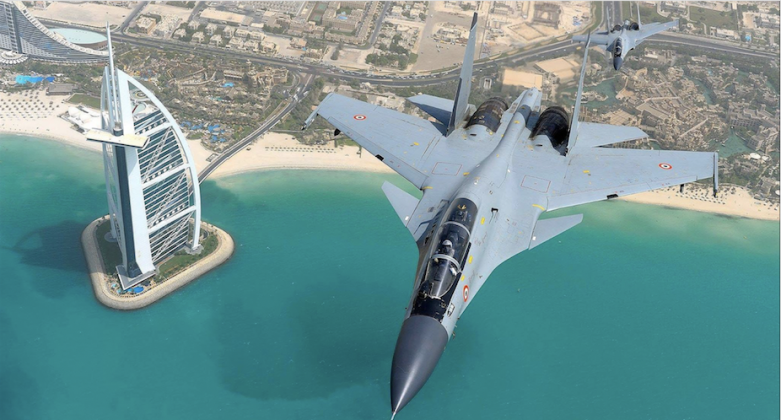
Indian Air Force Su-30MKI
Su-30MKI/MKA/MKM — India, Algeria, Malaysia
Developed from the late 1990s to meet the requirements of the Indian Air Force, the Su-30MKI was the first Su-30 variant with thrust vectoring engines and canards for added manoeuvrability, and benefitted form technologies previously tested during the development of the Su-37 program which later also found their way onto the Su-35. The fighter would become the most produced variant of the Su-30, with India becoming by far the largest Su-30 operator with a considerably larger fleet than Russia itself – largely due to the fact that Russia and China operated multiple classes of heavyweight fighter while India focused all its investment on the Su-30. Over 270 of the aircraft are thought to be in service, with the first having entered service in 2002 after beginning production two years prior, although prices would rise drastically as India began to produce the aircraft on less efficient domestic production lines and began to integrate more non-Russian technologies. By 2020 the aircraft built in India would cost almost twice as much as the newer and more capable Su-30SM. The Algerian Air Force and Royal Malaysian Air Force would subsequently order aircraft based on the Su-30MKI with relatively minor customisations — the Su-30MKA and Su-30MKM — with Algeria emerging as the third largest foreign operator for the class and ordering over 70 airframes.
Bypass the big tech censors by signing up to the new Russia Truth newsletter and get regular anti-NWO, pro-Russia news and updates –
Su-30M2 – Russia
One of the least widely used of the modern Su-30 variants, only 19 Su-30M2 fighters are currently in service all of which are used by the Russian Air Force. The aircraft completed factory flight tests in 2010 after four airframes were ordered the previous year, and are optimised for air to ground and anti shipping roles using precision guided weaponry. 16 more would be ordered in 2012. The aircraft are currently used for training purposes, with the Su-30’s standard twin seat configuration making it well suited to such a role. The fighter is derived from the Su-30MKI developed for India, but has significantly watered down capabilities compared to the Su-30SM which the Russian Air Force would eventually favour and is considered inferior to the Su-30MKI. Other than the Su-30SM, it is the only Su-30 variant currently in Russian service, and represented the first time Russia showed significant interest in aa 21st century Su-30 variant. Some Western sources have claimed that Russia’s decision to purchase the Su-30SM was influenced by the need to keep the Komsomolsk-on-Amur Aircraft Plant in business.
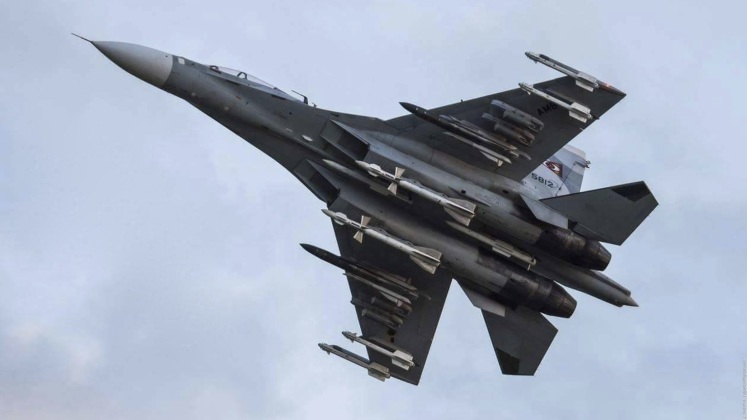
Venezuelan Air Force Su-30MK2 with R-27, Kh-31 and R-73 Missiles
Su-30MK2 — Venezuela, China, Vietnam,, Uganda, Indonesia
The Su-30MK2 was the most capable early variant of the Su-30 preceding the Su-30MKI which revolutionised the program. It was very closely derived from the Su-30MKK but built on it with improved avionics — most notably features affecting its command, control, communications, computers, intelligence, surveillance, target acquisition and reconnaissance capabilities. This included a new mission computer, communications systems, cockpit displays and the new Sokol radar that China reportedly jointly funded. The radar can engage 50% more targets simultaneously and has a larger antenna array, and notably has double the range against naval surface targets which optimises the fighter for a maritime strike role. The Su-30MK2 also benefits from the addition of electro-optical pods such as the Sapsan-E targeting pod and M400 reconnaissance pod. China was the first client for the aircraft and signed a contract for two dozen fighters, which would bring its Su-30 fleet to 97 airframes with the first deliveries made in 2004. All Su-30MK2s would be fielded by the country’s navy due to their optimisation for maritime strike roles. Modified variants of the aircraft were subsequently sold to Vietnam, Uganda, Venezuela and Indonesia, and those in Venezuela have long been considered the most capable fighters in Latin America.
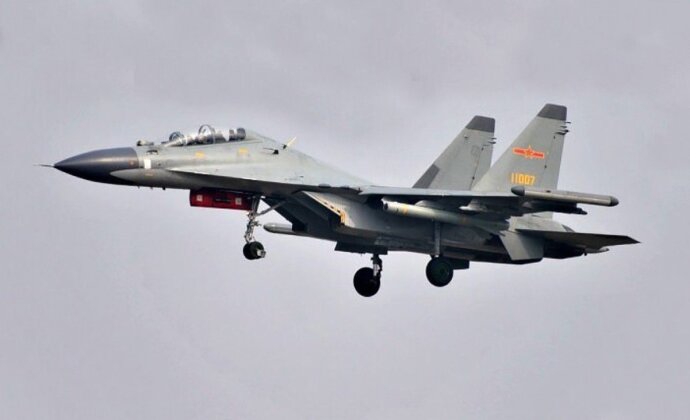
Chinese Air Force Su-30MKK
Su-30MKK — China
Commissioned by the Chinese People’s Liberation Army (PLA) in 1997 in response to the Taiwan Strait Crisis, which saw the U.S. Navy sail a carrier strike group less than 100km from the Chinese coast as a show of force against which China had little capability to respond, the Su-30MKK was developed specifically to meet China’s requirements. It was widely considered the most capable fighter in the world at the time. China already operated several dozen Su-27 fighters and was producing these under license domestically, but the performance gap between the Su-27SK and the Su-30MKK particularly in terms of sensors and avionics was very considerable. Chinese Premier Li Peng signed a $1.8 billion contract to purchase 38 fighters, making them significantly more expensive than the Su-27s, with further orders bringing the fleet up to 73 aircraft. State of the art long range communication systems, fly by wire controls, a glass cockpit, heads up display, helmet mounted sights, state of the art mission computers, and navigation systems capable of utilising both the GPS and GLONASS were among the features included on the fighters. They made use of a significantly higher percentage of composite materials relative to other Su-30 variants, and new aluminium alloys helped to reduce their weight while carbon fibre composite rudders increased their strength. The fighters were a game changer for China’s strike and maritime strike capabilities, although today they are among the older and less capable jets in the Chinese fleet.
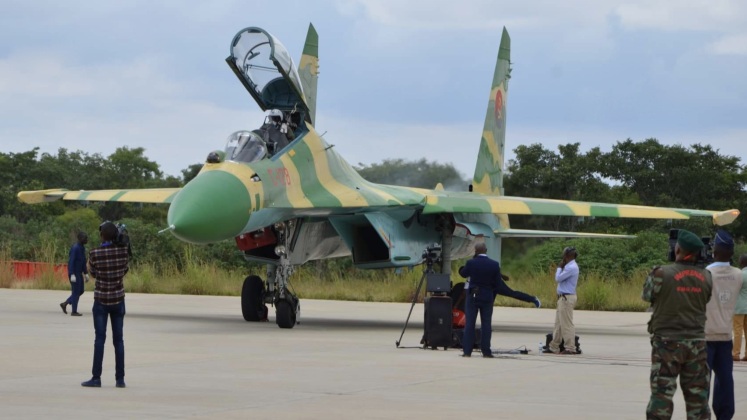
Angolan Air Force Su-30
Su-30K — Angola
A leading client for Russian fighters in sub-Saharan Africa, Angola acquired 12 Su-30K fighters with the first delivered in September 2017, with these purchased second hand after seeing brief service in the Indian Air Force before being returned to Russia and exchanged for the more capable Su-30MKI. The fighters have reportedly been heavily upgraded in Belarus, however, to bring them up to the Su-30SM standard, with their final designation remaining unknown. How comprehensive these upgrades have been remains uncertain, but considering that $1 billion was paid for the twelve aircraft enhancements were likely very comprehensive including new avionics, sensors and engines. The original Su-30K was the earliest and most basic variant of the fighter to be offered for export.
Source: https://tinyl.io/4iXo


